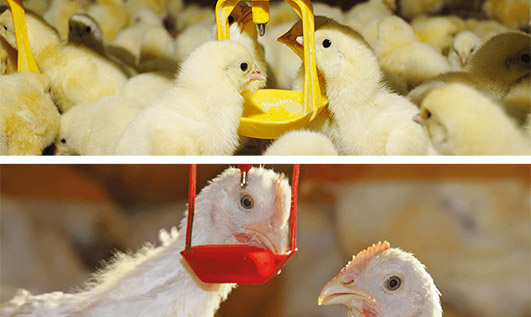How do chickens living in battery cage systems get the best water intake?
Now the battery cage system in Ghana is the most common way of poultry farming. Chickens can be well cared for in chicken coops, and automatic drinking water, feeding, manure cleaning, environmental control, etc. can be realized, so chickens living in poultry chicken cages for sale can get the best water intake.
The water consumption of chickens will be related to battery cage system, water consumption and season. The following is an introduction to the optimal water intake of chickens in different periods and conditions for poultry farmers.

- Increasing age: 1-6 weeks old chicks, 20-100 ml per chick per day; 7-12 weeks; young hens, 100-200 ml per hen per day; 200-230 ml per hen for poor hens; laying hens 230 to 300 ml.
- The ratio of water consumption to input power: under normal temperature (20°C), the amount of water added is 2 times; under high temperature environment (35°C), the amount of water added is 5 times.
- The amount of drinking water increases with the increase of egg production rate: the egg production rate is 50%, and the daily water required by laying hens is 170ml; after the egg production rate increases by 10%, the water consumption increases correspondingly by 12ml.
- Seasonal changes in water intake: 100 ml per chicken per day in winter, 200 ml per chicken per day in spring and autumn; 300 ml per chicken per day in summer.
The above is the chicken farming information shared by chicken farm equipment manufacturers for you. The use of battery cages systems has been proven to give chickens optimal water intake. Please feel free to use it for farmers who use chicken raising equipment.
Reasons for the formation of battery chicken cages for laying hens
The most important thing in laying hens is the egg production rate. 60 years ago, the social demand for eggs increased rapidly, and the high mortality of free-range chickens and chickens could not meet the needs of the society. So the trend of using battery chicken cages for laying hens to breed chicken began.
With the advancement of technology, automatic chicken raising equipment is now very popular. Modern chicken cage systems in use today are clean, automated and efficient. Modern sheds include automatic feeding, drinking, climate control maintained at 23°C, ventilation, lighting, and manure and egg collection. This efficient system allows farmers to optimize conditions for bird health and produce eggs at relatively low cost.
In addition, the use of laying hen cages allows chickens to be well protected, not only to avoid the invasion of animals, but also to avoid the invasion of pathogens.

The length of the battery chicken cages is generally 1,800 square centimeters to 11,000 square centimeters. Chickens can move freely, drink water and eat in this space. Because the trough is next to the iron mesh of the chicken cage. And there are two drinking nipples in a chicken cage, which can supply sufficient water for chickens at any time.
Layer cages are sometimes referred to as battery hen cages. Because parallel rows in poultry cages using automated chicken equipment look a bit like rows of batteries within a battery. Over the years, caged egg farming has attracted the approval of most poultry farmers. The hens are well cared for in the chicken coop, and can achieve free drinking water, eating, and a good living environment brought by the automated manure removal system and automated environmental control system.
The technology of raising chickens in modern poultry cages is very mature. Its convenience is also recognized by many poultry farmers. If you are also interested or want to know more about automated chicken raising equipment, please follow me.
How to control the temperature control of chicken cages at different stages
In the process of using battery chicken cages to raise chickens, it is very important for breeders to control the temperature of the chicken house and control the temperature of the chicken house at a stage suitable for the growth and development of chickens.
Too high or too low temperatures can have an impact on the healthy growth of chicken flocks, affecting feed intake and activity and, in serious cases, leading to widespread mortality. Therefore, attention must be paid to the control of temperature in the chicken house. Here are the temperature requirements for different growth stages of chickens.
The first is the brooding period. Poultry farmers know that during the brooding period, the breeder should set the temperature of the coop before entering the brood. Adjust the insulation in the coop before brooding and check that radiators and pipes are not leaking and heating up.

Then comes the temperature control in the poultry battery cages. Different breeds of chickens generally have different temperature requirements, so poultry farmers need to work well in advance to create the right temperature for the house. This will allow the chicks to adapt and grow up healthily.
The final point is the control of the temperature in the chicken house during the rearing period. Good control of the coop temperature and weather changes is to make the appropriate adjustments.
These are the appropriate temperatures required for the different growth stages of chickens in the battery chicken cages rearing process as arranged by the poultry equipment manufacturers for the farmers. The appropriate temperature can promote the healthy development of chickens in chicken farms. So the majority of farmers must pay more attention to the temperature of the chicken house.
